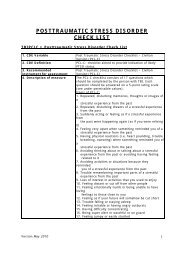TMT - TBI-IMPACT.org
TMT - TBI-IMPACT.org
TMT - TBI-IMPACT.org
You also want an ePaper? Increase the reach of your titles
YUMPU automatically turns print PDFs into web optimized ePapers that Google loves.
NEUROPSYCHOLOGICAL IMPAIRMENTNeuropsychological impairments are frequent following <strong>TBI</strong>. Extensive testing can be implementedto capture subtle and overt impairments.It should be noted that routinely administered neuropsychological test batteries may not alwayspermit detection of impairments in cognitive and executive functioning after <strong>TBI</strong>.The RAVLT and the CVLT-II tests are measures of word list learning and belong to the most widelystudied measures of cognition with extensive normative data. The RAVLT is available in the publicdomain. The CVLT is copyrighted to NCS, Pearson, Inc.The WAIS III/WAIS IV Processing speed Index is based on the Digit Symbol Coding and SymbolSearch subtests of the WAIS III/IV. It is a measure of information processing rate and highlysensitive to the effects of <strong>TBI</strong>.The <strong>TMT</strong> is a measure of attention, speed and mental flexibility.References:Schmidt M. Rey Auditory Verbal Learning Test. Los Angeles: Western Psychological Services;1996.Strauss E, Sherman EMS, Spreen O. Rey-Osterrieth Auditory Verbal Learning Test. Compendiumof neuropsychological tests.New York: Oxford University Pr; 2006. p 776–807.Wechsler D. Wechsler Adult Intelligence Scale III. San Antonio: Harcourt Assessment Inc; 1997.Wechsler D. Wechsler Adult Intelligence Scale IV. San Antonio: Harcourt Assessment Inc; 2008.Corrigan JD, Hinkeldey MS. Relationships between parts A and B of the Trail Making Test. J ClinPsychol. 1987;43(4):402–409.Gaudino EA, Geisler MW, Squires NK. Construct validity in the Trail Making Test: what makes PartB harder?J Clin Exp Neuropsychol. 1995;17(4):529-535.
Trail Making Test (<strong>TMT</strong>) Parts A & BInstructions:Both parts of the Trail Making Test consist of 25 circles distributed over a sheet of paper. In PartA, the circles are numbered 1 – 25, and the patient should draw lines to connect the numbers inascending order. In Part B, the circles include both numbers (1 – 13) and letters (A – L); as inPart A, the patient draws lines to connect the circles in an ascending pattern, but with the addedtask of alternating between the numbers and letters (i.e., 1-A-2-B-3-C, etc.). The patient shouldbe instructed to connect the circles as quickly as possible, without lifting the pen or pencil fromthe paper. Time the patient as he or she connects the "trail." If the patient makes an error, pointit out immediately and allow the patient to correct it. Errors affect the patient's score only in thatthe correction of errors is included in the completion time for the task. It is unnecessary tocontinue the test if the patient has not completed both parts after five minutes have elapsed.Step 1: Give the patient a copy of the Trail Making Test Part A worksheet and a pen or pencil.Step 2: Demonstrate the test to the patient using the sample sheet (Trail Making Part A –SAMPLE).Step 3: Time the patient as he or she follows the “trail” made by the numbers on the test.Step 4: Record the time.Step 5: Repeat the procedure for Trail Making Test Part B.Scoring:Results for both <strong>TMT</strong> A and B are reported as the number of seconds required to complete thetask; therefore, higher scores reveal greater impairment.Average Deficient Rule of ThumbTrail A 29 seconds > 78 seconds Most in 90 secondsTrail B 75 seconds > 273 seconds Most in 3 minutesSources: Corrigan JD, Hinkeldey MS. Relationships between parts A and B of the Trail Making Test. J ClinPsychol. 1987;43(4):402–409. Gaudino EA, Geisler MW, Squires NK. Construct validity in the Trail Making Test: what makes PartB harder? J Clin Exp Neuropsychol. 1995;17(4):529-535. Lezak MD, Howieson DB, Loring DW. Neuropsychological Assessment. 4th ed. New York: OxfordUniversity Press; 2004. Reitan RM. Validity of the Trail Making test as an indicator of <strong>org</strong>anic brain damage. Percept MotSkills. 1958;8:271-276.







